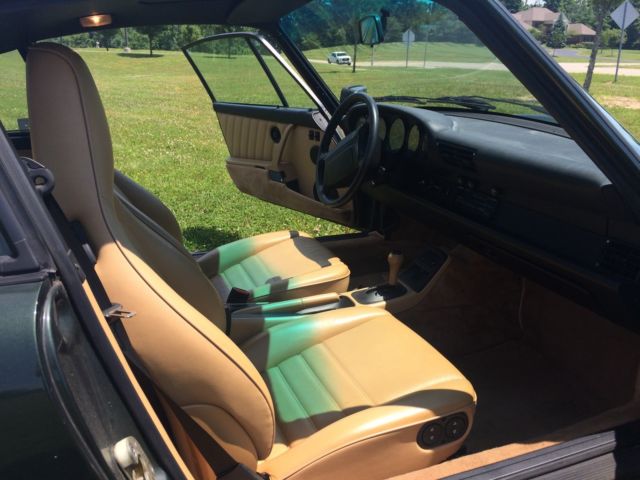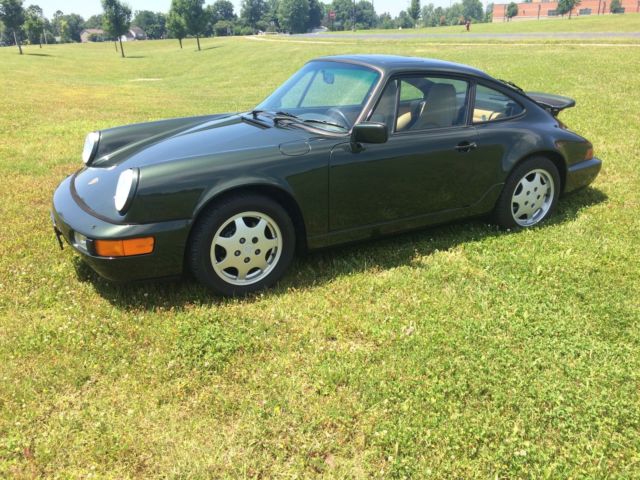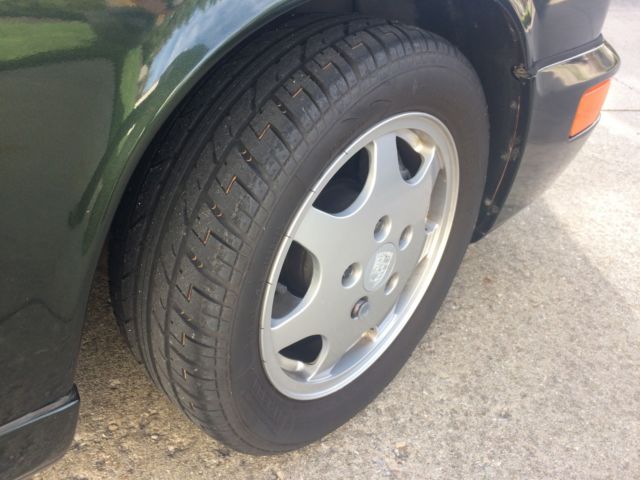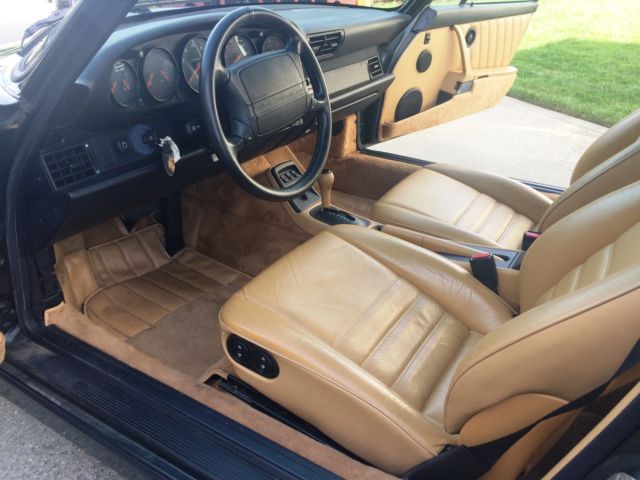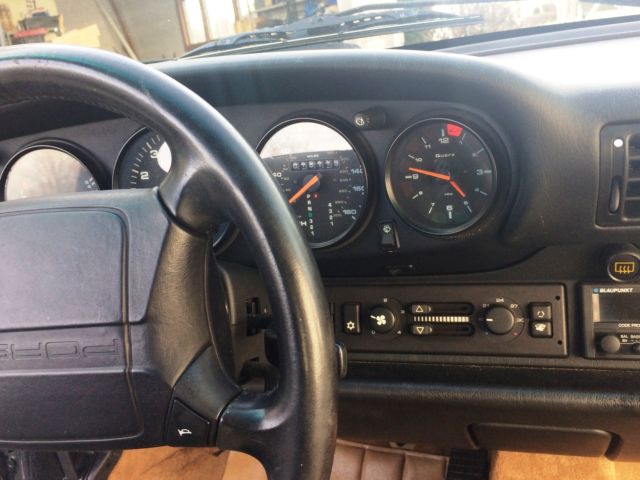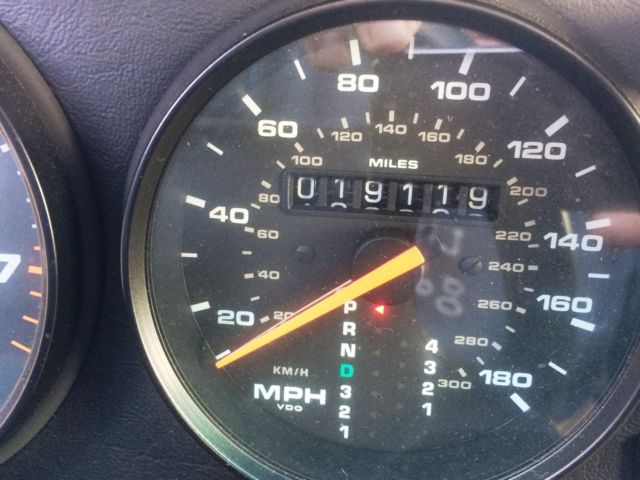1991 Porsche 911 C2 Coupe
- Condition: Used
- Make: Porsche
- Model: 911
- Type: Coupe
- Year: 1991
- Mileage: 19,000
- VIN: WP0AB2960MS410616
- Color: Green
- Number of cylinders: 6
- Power options: Air Conditioning, Cruise Control, Power Locks, Power Windows
- Fuel: Gasoline
- Transmission: Automatic
- Interior color: Tan
- Safety options: Driver Airbag, Passenger Airbag
- Options: Cassette Player, Leather Seats, Sunroof
- Vehicle Title: Clear
- Location: Pickerington, Ohio, United States
Description
1991 Porsche 911 C2 (19,600 miles)
I’m the second owner of this awesome vehicle. I bought it from an executive from Red Roof Inns and he got tired of waiting on a special order, forest green 911, so he bought this candy apple red 911 and had a $10,000 paint job on it. He must have had a lot of money and was very impatient to do such a thing. The only part that did not get painted was the sunroof (interior), when it is opened, and the spare tire. I bought this beauty in 1994 and have kept it garaged 100% of the time. I only drove the car in good weather (no rain, snow) and kept it under a car cover inside the garage when not in use. The car had 9669 miles when I bought it and only has 19,000 miles now. It has a new battery, new tires all around and is in excellent condition. I’m only getting rid of it because I don’t enjoy it as much as I should and know there are lots of Porsche enthusiasts out there that would die to get their hands on a 27 year old car in such excellent condition with extremely low miles. It runs just as you would expect a Porsche to run and still has excellent acceleration. I love driving it, but I just can’t justify having the car anymore since I rarely drive it and have three other vehicles (Ford Edge (2) and a Jeep Liberty). Tiptronic transmission.
Needs lots of little things done to make it “perfect” again. Speakers need replaced. Radio/cassette is original and, all of a sudden, stopped working (cassette player still works). Some minor oil leaks on the garage floor. AC doesn’t work…all it needs is a R12 re-charge (I have one can that will come with the sale of the car). Very small (dime size) dent above side rear quarter panel of car. There is also a tiny spot of what looks like surface rust in the same area (odd area) (a couple of bumps the size of an eraser). Warning light just began to come on (diagnosed that one of the speed sensors is bad….causes the speedometer, odometer and spoiler not to work as designed). Not sure which one is bad….each speed sensor is specific to each wheel (not a universal part). Short in the battery terminal/cable. I keep car on trickle charge as it is rarely driven. Even though, when I go to start the car, nothing happens from time to time. I move the battery connection cables and then it starts. Had battery changed (new battery) but it still has same symptoms from time to time. There doesn’t appear to be any problems with the cables as there is no corrosion. Lots of small paint chips on the front bumper from previous owner. I have cracks (small BB holes) in one headlight and both front parking lights. I even wonder if someone shot these out with a pellet gun or something because I have never been behind a gravel truck or noticed the holes when I first purchased the vehicle. It’s really odd.From Hagerty.com:
History of the 1990-1994 Porsche 911The new 964 version of the Porsche 911 that was launched in 1989 was seen as rather futuristic in its day due to the smooth integration of its body-color bumpers and front bodywork with the body itself; but looking back, the 964 cars now fit neatly in Porsche history, leading up to the 993 models that bid farewell to a long legacy of air-cooled 911s.
While the car looked suspiciously like it might be a mere reskin of the 930, 87 percent of the components were new or redesigned, according to Porsche. The flat-six engine was pushed out to 3.6 liters and 250 hp—with strong and steady torque delivery—and this generation was known by enthusiasts as far more dynamically predictable than the 930.
The four-wheel-drive Carrera 4 was the form in which the 964 made its debut in 1989, and it is now mainly selected by connoisseurs in snowy states due to its all-weather tractability. The two-wheel-drive Carrera 2 is often cited as the more engaging version of the 964 cars from a driver's standpoint, as the cars are about 220 pounds lighter and have a bit more front trunk space. Targa and Cabriolet versions followed.
Initially, 911 Turbo models inherited a refined version of the 3.3-liter engine from the 930, making 320 horsepower. But for 1993 and 1994, the Turbo 3.6 was introduced; with a stronger 360-hp engine, these models are the most sought-after of the 964s, with less than 1,600 made in all.
All the 964 Porsches are also distinguished by their large rear spoilers that extend upward at 50 mph, then return to rest position below 6 mph.
The 964 today appeals to Porsche aficionados for its somewhat more refined ride and handling (with coil springs and shocks in back), and much-improved cabin comforts—including a full-length center console, and height-adjustable leather seats—combined with an overall driving experience that's a little more direct compared to the 993 that followed it.
Anti-lock brakes were standard on all models, as were dual front airbags. A dual-mass flywheel and variable-assist power steering added to the advances in refinement, and a four-speed Tiptronic automatic transmission was optional for the first time. Only 62,172 of this generation were built—less than either the 930 it replaced or the 993 it preceded.
These cars got automatic climate control, as well as more effective air conditioning and heating systems. Models with Tiptronic also had an onboard trip computer.
The RS (Carrera Cup USA) and RS America are two other sought-after models. With significant weight savings, these models feel more sprightly than the other 964 models, and they're more desirable today because of it—and generally worth more, even though in the case of the RS America they cost less when new.
Common issues with this generation include oil leaks and, in 1990-92 cars, issues with the dual-mass flywheel, which should be replaced. In high miles the engines often need a top-end rebuild, and front-end bushings need to be entirely replaced. Costly chain tensioner problems were also widely reported with the 1989 Carrera 4, though most have now been sorted.
">The new 964 version of the Porsche 911 that was launched in 1989 was seen as rather futuristic in its day due to the smooth integration of its body-color bumpers and front bodywork with the body itself; but looking back, the 964 cars now fit neatly in Porsche history, leading up to the 993 models that bid farewell to a long legacy of air-cooled 911s.
While the car looked suspiciously like it might be a mere reskin of the 930, 87 percent of the components were new or redesigned, according to Porsche. The flat-six engine was pushed out to 3.6 liters and 250 hp—with strong and steady torque delivery—and this generation was known by enthusiasts as far more dynamically predictable than the 930.
The four-wheel-drive Carrera 4 was the form in which the 964 made its debut in 1989, and it is now mainly selected by connoisseurs in snowy states due to its all-weather tractability. The two-wheel-drive Carrera 2 is often cited as the more engaging version of the 964 cars from a driver's standpoint, as the cars are about 220 pounds lighter and have a bit more front trunk space.
All the 964 Porsches are also distinguished by their large rear spoilers that extend upward at 50 mph, then return to rest position below 6 mph.
The 964 today appeals to Porsche aficionados for its somewhat more refined ride and handling (with coil springs and shocks in back), and much-improved cabin comforts—including a full-length center console, and height-adjustable leather seats—combined with an overall driving experience that's a little more direct compared to the 993 that followed it.
Anti-lock brakes were standard on all models, as were dual front airbags. A dual-mass flywheel and variable-assist power steering added to the advances in refinement, and a four-speed Tiptronic automatic transmission was optional for the first time.
These cars got automatic climate control, as well as more effective air conditioning and heating systems. Models with Tiptronic also had an onboard trip computer.
1991 Porsche 911 Carrera 2 Info
- 0" >
- Body Styles
- 2dr Cabriolet
- 2dr Coupe
- 2dr Targa
- 0" >
- Engine Types
- 6-cyl. 3601cc/247hp FI
- Additional Info
- Curb Weight: 3031 lbs.
- Vehicle Length: 168.3 in.
- Wheel Base: 89.4 in.
- Number Produced
- 702
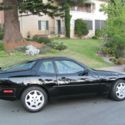 1991 Porsche 944 S2 Coupe, only 45K miles
1991 Porsche 944 S2 Coupe, only 45K miles
Mileage: 44600
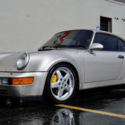 1991 Porsche 911/964 Turbo Coupe
1991 Porsche 911/964 Turbo Coupe
Mileage: 72300
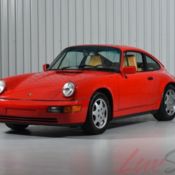 1991 Porsche 964 Carrera 2 Coupe
1991 Porsche 964 Carrera 2 Coupe
Mileage: 75,000
 1991 Porsche 964 Carrera 4 Coupe
1991 Porsche 964 Carrera 4 Coupe
Mileage: 25,000
 1991 Porsche 911 C4 Coupe 2-Door 3.6L
1991 Porsche 911 C4 Coupe 2-Door 3.6L
Mileage: 63,884
 1991 Porsche 911 Turbo 2dr Coupe
1991 Porsche 911 Turbo 2dr Coupe
Mileage: 89,700
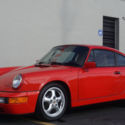 1991 Porsche 911/964 Carrera 2 Coupe
1991 Porsche 911/964 Carrera 2 Coupe
Mileage: 44671
 1991 Porsche 911 Turbo Coupe 2-Door 3.3L
1991 Porsche 911 Turbo Coupe 2-Door 3.3L
Mileage: 57,557
 1991 Porsche 944 S2 Black 2DR COUPE S2 Manual
1991 Porsche 944 S2 Black 2DR COUPE S2 Manual
Mileage: 38,575
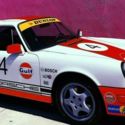 1991 Porsche 911 C4 964 Manual 5 Speed Coupe
1991 Porsche 911 C4 964 Manual 5 Speed Coupe
Mileage: 115


